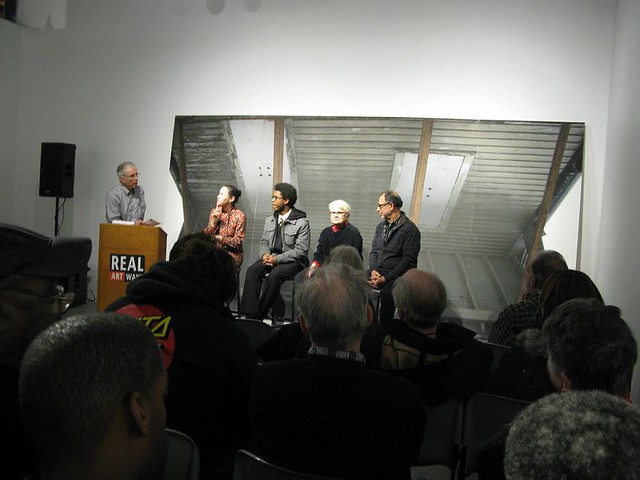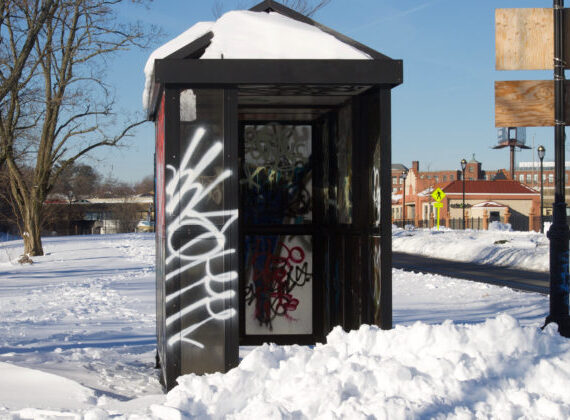
The snow did not deter folks from coming out on Saturday for a community dialogue about how our surroundings shape us. Real Art Ways hosted this event, co-presented by the Hartford Public Library.
Lourdes Correa-Carlo started the discussion by way of providing background on her art in general and her two pieces — Vigilance Structure and Inverted Structure — currently on display at Real Art Ways. While visiting her mother in Hartford, Correa-Carlo used photography to help her explore the community. She said she “started photographing in Hartford without knowing anyone” other than her family.
The artist said she had “a visceral reaction” to the landscape here and was interested in “how ideologies are embedded in structures,” like that of the I-91 pedestrian bridge.
In her depiction of the bridge, its prison-like elements are drawn out, specifically, the sense that it is a Panopticon — a structure that symbolizes and actualizes how power functions across systems in our society. Though the Panopticon design was created by Jeremy Bentham, it was Michel Foucault who presented the idea that this power structure is found beyond prisons: “We are neither in the amphitheatre, nor on the stage, but in the panoptic machine, invested by its effects of power, which we bring to ourselves since we are part of its mechanism.”
The Panopticon design is such that the prisoners are on the inside, with guards potentially stationed all around. It’s circular and the prisoners can not see the guards; therefore, they are given the sense of being watched at all times by an invisible eye. Because it is not known when they are being watched, the message is that they must act as if they are under constant surveillance.
The experience of walking inside of the I-91 pedestrian bridge is not unlike that. Carlos Hernandez Chavez, a local musician and artist, said of the bridge that it “is the bureaucratic aesthetic of the State.”
Toni Gold, another panelist, said she thinks of “it as a prison for environmentalists” as “it was an early interpretation of mitigation,” an “early attempt to assuage the environmentalists.” Under the 1970 National Environmental Policy Act, it was mandated that major projects using federal funding had to alleviate some of the environmental harm done by construction. Gold seemed to believe that the government has gotten better at how it mitigates harm now, but given some of the Flower Street mitigation plans tossed around for a solid year before the Connecticut DOT’s recent switch to more thoughtful designs, I would not be so sure.
In small group conversations, participants shared how they have used or seen the pedestrian bridge being used, from those who said it seemed wholly unused to those who have taken part in a Real Ride on/through it — a nighttime bicycle group ride involving attaching extra lights and other decorations to the bicycles, an event more akin to a parade than an athletic experience. Jamil Ragland, one of the panelists, said that when growing up, the bridge “scared” him at first because he is afraid of heights. As a longtime Hartford resident, he had assumed for awhile that the bridge connected Downtown to “the dump” because he did not know a park was by the river.
From Riverside Park, the bridge seems accessible, but from Downtown, it appears tucked away in a lot behind a gas station. There are no signs indicating where the bridge goes, giving those not in the know no reason to use it.
The bridge is a prime example of what happens when the public is not consulted. Gold said, “the more input the community has,” the better the results, but both community members and experts are needed. In conversation some chimed in with what they would prefer to see happen to the bridge: paint it pastel colors, turn it into a giant trellis, and make it into an aviary were a few thoughts.
A “change to this would require imagination,” Ragland said, “a level of imagination that I don’t possess.”
Lourdes Correa-Carlo’s work is on display at Real Art Ways through January 5, 2014.


Justin
I liked the suggestion at the forum, made by one of the panelists, that Hartford pull out a call for an architectural/design competition to re-imagine the highway environmentalist prison walkway.
This would mean a lot of outside input on a Hartford ‘problem’ (or rather a Hartford potential/possibility) but is a chance to get the right kind of input. Unlike hiring one tone-deaf design firm from Boston we could get a ton of cool ideas from designers and architects from all over the country and the world. Scrappy little design firms and partnerships who are actually interested in community input and simple, cheap ways to reimagine infrastructure like this.
Maybe in part the problem isn’t so much that out-of-town agencies and groups are being consulted on Hartford’s future and planning, but maybe we’re not getting them from far enough away–maybe we should think of think of striving for more cosmopolitanism, not less–heck with Boston, what do folks in Copenhagen and San Francisco and Jacksonville have to contribute? Then Hartfordites can sit down with the entries and see if we like any of the ideas.
I thought it was pretty cool to hear the idea of a competition thrown out at the event at RAW on Saturday.
– Justin
Justin
make that “put out a call”
Kerri Provost
The idea of an RFP for bridge art came up at one of the Downtown North meetings, but wasn’t mentioned at last, where emphasis was one building another structure.
I could personally envision something like what was done with the Pelican Tattoo building on Park Street happening here: http://sofiarte.blogspot.com/2009/06/real-public-hartford-ct.html
Justin
Oh that would be rad–that mural on the tattoo art building is awesome and seems like a rare standout here.
Brendan
Some other cool murals in that Park/Broad area thanks to this guy: http://www.vicpacheco.com/
Chris Brown
Some salvaged early mural panels of Victor’s are on display inside the Park Branch of the Hartford Public Library (corner Park & Babcock) He does really great work.